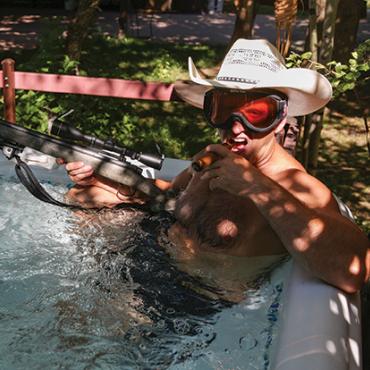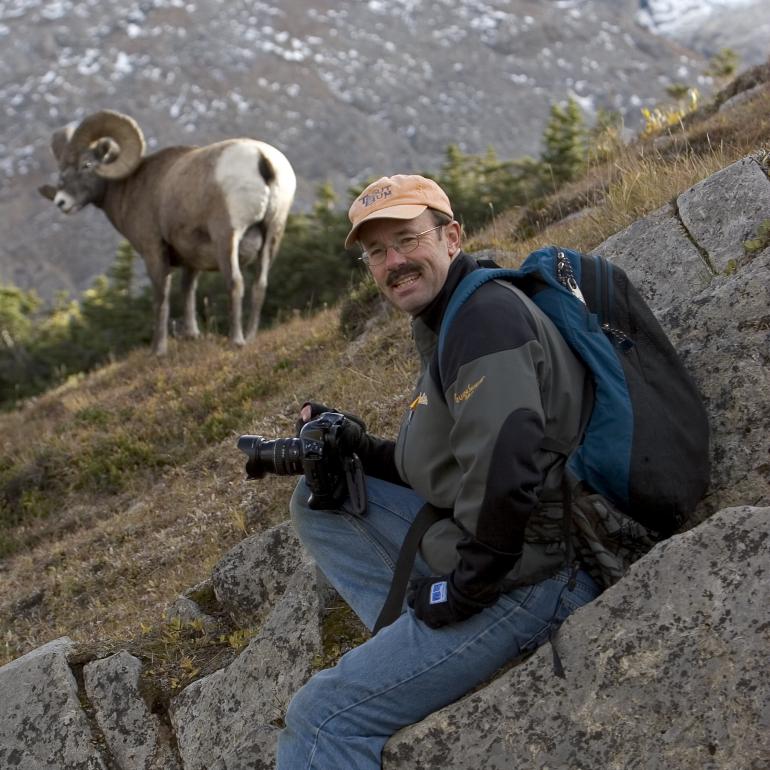The Life of Bryan
We’ve all seen the pictures, in a dentist’s office or outdoor shop or in the living room of a friend’s house. A sleek whitetail buck bounds over a wooden fence in an effortless five-foot-high leap. A lone wolf stands amid a grove of aspens, his gaze penetrating and his mottled coat blending into the snow-draped woods behind. Silhouetted against a rising full moon, a stately bull elk crests a mountain ridge. There are more, of course, dozens more, but these are among the most awe-inspiring shots—the stop-dead-in-your-tracks, “Wow, look at that!” images—that once seen, are seldom forgotten. And these are the images that have helped distinguish Bozeman resident and avid outdoorsman Denver Bryan as one of the most talented, highly acclaimed, and frequently published wildlife photographers in the country.
With seven photographic books, over 200 magazine covers, and bylines in numerous national magazines—including National Geographic, Field & Stream, Gray’s Sporting Journal, and Smithsonian—to his credit, Denver Bryan is surprisingly self-effacing about his photographic achievements. “I’m where I am today because of a genetic defect,” claims the tall, dark-haired 50-year-old, a wry grin barely discernable beneath his well-trimmed moustache. “Nobody in my family is capable of working for someone else, so we’re all self-employed.” It’s this kind of light-hearted attitude—combined with an abiding love of the natural world and a gritty, unaffected self-confidence—that informs much of Bryan’s photography, and his life in general.
Go West, Young Man
Bryan grew up in Missouri, and after completing a master’s degree in wildlife biology, he decided to shift gears. “I realized I didn’t want a life in bureaucracy,” he says, which is where most wildlife biologist jobs are found. So he did what any young, disaffected outdoor enthusiast from the Midwest would do—he pointed his car west. Right off the bat he took a job guiding raft trips down the Snake River near Jackson, Wyoming. It was here that Bryan began experiencing the vast, open country he’d dreamed about as a boy. Eventually he began writing about nature and his adventures—and not long after, taking pictures of them. “Editors told me I could sell my articles more easily if I had pictures to go with them,” he recalls. “So I bought a camera.”
He soon found that he liked photography better than writing. “Writing was hard work,” he says, and he found that he much preferred the suggested counterpart. Before long he’d decided to make a go at a career in photography. He spent the first few years traveling, selling his framed wildlife photographs at juried art shows on weekends. “Those were my starving-artist, road-warrior years,” he recalls. “I was able to see most of the country, and especially the West where I knew I wanted to eventually settle.” And all the while, he was honing his craft: studying light and shadow, finding new and better locations, shooting lots of film—in short, learning the art and business of photography.
After five years of photographing wildlife from Alaska to Mexico, Bryan decided he had enough images in his library to settle down and work on the business end of selling stock photography. “Taking good pictures is only half the battle—it’s actually the fun and easy half,” he explains. “You’ve got to know how to market your work.” Marketing was obviously another natural talent, for in short order Bryan moved to Bozeman (having discovered its charms during the Sweet Pea Festival), established a Main Street office, and hired an office manager to help with the increasing influx of requests for his images from magazines around the country. “I had quite a bit of discipline back then,” he remembers. “I worked hard—maybe too hard, as I seldom left the camera at home to enjoy the outdoors on its own.” He also broadened his photography to include both fly fishing and hunting, expanding and diversifying his markets. The result was more work, more assignments, and more traveling: throughout the U.S., Canada, and Alaska; to Chile, Costa Rica, the Caribbean, and the South Pacific; and to numerous countries in Africa.
Nowadays, he’s reaping the benefits of all those long work weeks. “I’m pretty lucky,” he says. “These days, I pretty much photograph what I want and then find places to sell my images.” When he travels, he does it mostly on his own terms, with every trip being a healthy balance of business and pleasure. And as a lifelong fly fisherman and hunter, he’s making up for lost time by shooting less film and carrying a fly rod more often.
From Bozeman to Botswana
As much as Bryan’s career was forged by hard work and determination, other aspects of his life have happened completely by chance. Nine years ago, his visiting nephew plowed into a woman’s car near his home on Bozeman Ave. Bryan walked to the scene to offer assistance, and four years later to the day, he and Anne, the hapless driver, were married. It just so happened that Anne was the field director for an African safari company based in Kenya. Bryan had found a kindred spirit, a fellow admirer of a place dear to his own heart. “Southern Africa is pretty much becoming our snowbird location,” he says. “We love it there. The Okavango Delta in Botswana—with its great light, excellent wildlife, and top-notch game lodges—that’s one of my favorite places on Earth.” Bryan also loves to fly fish for tigerfish in the nearby Zambezi River, and claims that the mountains of South Africa have some unexpectedly good trout fishing.
It should be no surprise, then, that trout fishing is one of the things that keeps Bryan in Bozeman. Many of his best fishing images are taken on the nearby Gallatin, Yellowstone, and Madison rivers. “The quality of life here is wonderful,” he says. “Despite the rampant growth of the past decade or two, it only takes a few minutes to get out of town to a mountain trail, river, or other quiet parts of Montana that brought most of us here.”
Captivity and Controversy
While some photographers eschew all photographs except those of truly wild animals, Bryan takes a different stance. “There’s nothing wrong with photographing captive wildlife at a game farm,” he states. There’s only a handful of such places around the country, Bryan says, and in addition to being inspected and sanctioned by their respective states, “the people who run them truly love the animals they raise and take care of.” As a wildlife biologist he also points out that some wildlife are extremely shy and next to impossible to photograph in the wild, and to do so often constitutes harassment and may compromise their reproductive success. He says that from a professional perspective, photographers should simply be “upfront and honest,” passing along information to the magazine editors who ultimately publish their images. Bryan also thinks most of the criticism comes from a small number of photographers “who want to build themselves up by tearing down others, an unfortunate side of human nature.”
And what about Photoshop, that revolutionary (and equally controversial) program that lets you magically remove a telephone pole, or a shadow, or a hundred other undesirable elements in a photograph? “Same thing,” Bryan replies, just as unapologetically. “Photoshop allows photographers to do many of the same things, and more, that Ansel Adams did to enhance his prints in the darkroom. Or, it can lend itself to creationism.” Again, says Bryan, the important thing is to be upfront about it, to magazine editors or to anyone who inquires. “Generally speaking,” he explains, “enhancement, not creation—especially in the editorial marketplace—is the general rule.”
Words of Wisdom
When it comes to advice for aspiring photographers, Bryan keeps it simple. “Shoot what interests you and you’ll do your best work,” he advises, “and keep working at it.” An education in photography can be helpful, he says, but most good outdoor photographers (himself included), are self-taught. Ability is innate, he believes; in large part, you either have it or you don’t. However, like most talents, you can definitely develop your skills, says Bryan. From a technical perspective, he emphasizes quality. “Use good film or digital and shoot with good lenses,” he says.
Ultimately, Bryan says, nothing beats experience—and perseverance. “Don’t get discouraged,” he says, “or think you have to be well known to get published. Most editors care more about the quality of your work than your name.” Easy for him to say, of course, but this advice brings to mind the words of 19th-century statesmen and brilliant orator Daniel Webster: “There’s always room at the top.” So, says Bryan, “Follow your dream. Give it a few years at least. If it doesn’t work out, you can always look elsewhere, but you can walk away knowing you gave it a shot.”
As for his own inherent (and considerable) talent, Bryan denies that he has any special gift beyond a good eye for light and an extensive knowledge of animal behavior, which helps him in the field. Pry open that reticence, however, and he does admit to enjoying those moments when “light, subject, and behavior” all come together to offer a fleeting opportunity to capture a magical moment in time. “It’s the convergence of these three elements,” he says, “that often most inspire me.” That inspiration is what brings his photographs to life, elevating them from ordinary to extraordinary—photos that don’t simply capture a moment, but that tell a story. And it’s those stories that grab our attention, draw us in, and make an indelible imprint on our minds.
Work or Play?
Soon Bryan will head off again to shoot photos in his beloved Africa: a “work trip” doing what tourists pay thousands of dollars to do on a guided photographic safari. For the past few years he’s focused on lions, leopards, and other “big nasties” as he likes to call them. “Yeah, I’ve got a great job alright,” Bryan admits. “The government lets me call it work but none of my friends do.”
So now that he’s finally able to enjoy the life he’s worked so hard for, one might expect Bryan to spend all his free time traversing the globe, seeking constant adventure in distant lands. Not so—at least not as much, anyway. “That’s one of the great ironies of life,” he says. “When you’re young, you have a great desire to travel everywhere but usually not enough means. But now that I have the means, I find that I don't have near as much desire.” While he still loves a good challenge or trip, apart from his African travels, Bryan is considerably more sedentary than in years past, content to explore more of his own backyard. The haphazard days of yore—descending raging rivers and chasing (and being chased by) Cape Buffalo—are not so numerous. “I’ve tempted fate enough times,” he says, “Moderation and diversity are two big themes in my life now. These days I try and slow down and appreciate things a bit more.”
But make no mistake: this unforeseen temperance does not mean that Bryan has any regrets. “Those starving artist years, and the reckless days of youth, were in some ways the best years of my life,” he says, leaning back in his chair and gazing at the office walls adorned with fishing, hunting, and wildlife shots from 30 years of traveling the world, camera in hand, eyes searching for that magical, fleeting combination of light, subject, and behavior. “All in all, it’s been a fun ride... and it still is.”
For more information about Denver Bryan’s award-winning photographs, or to order posters, fine art prints, or digital images, visit www.denverbryan.com. Denver currently has an exhibit inside Preston’s clothing store in downtown Bozeman, where much of his North American and African wildlife images are displayed.













